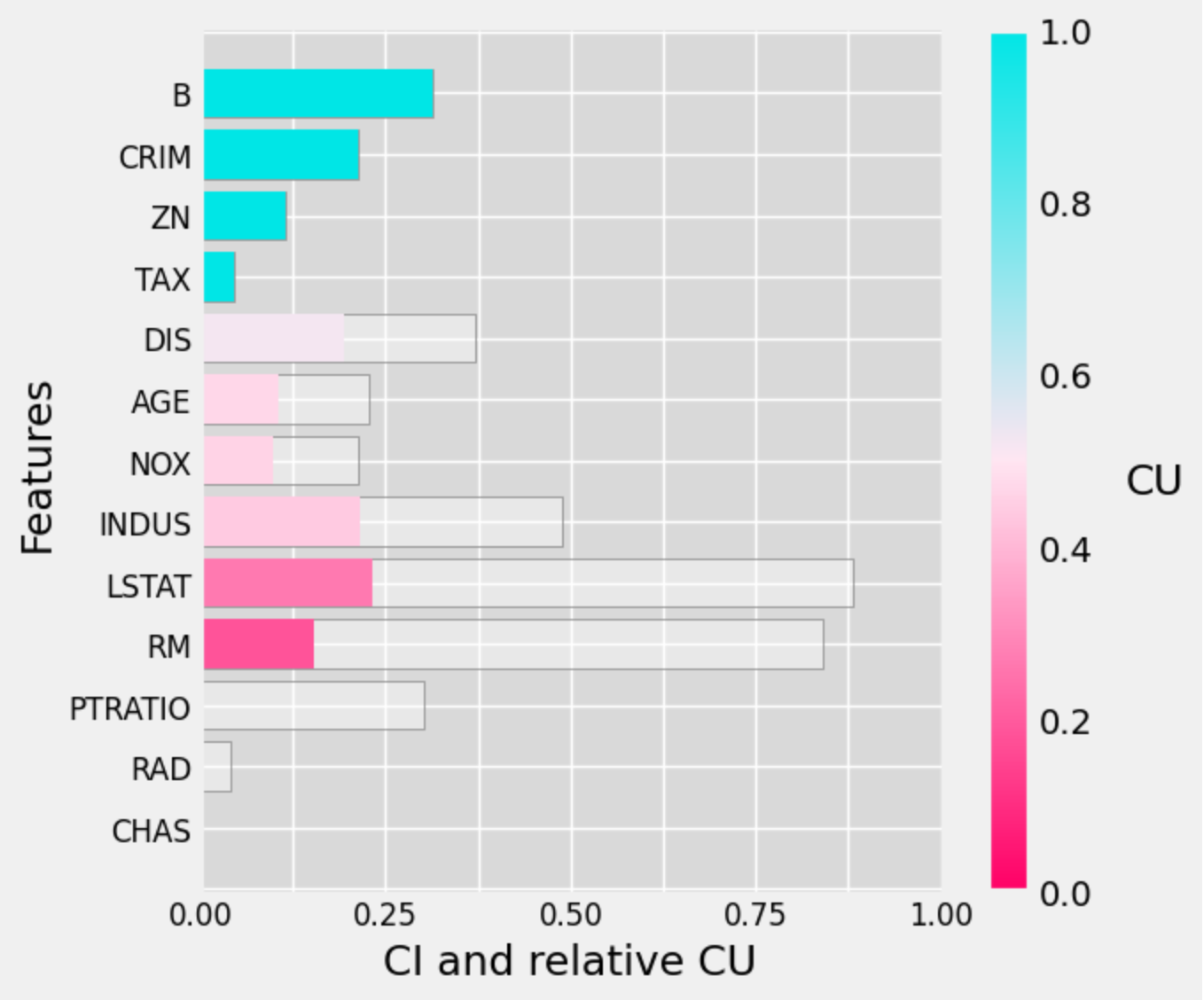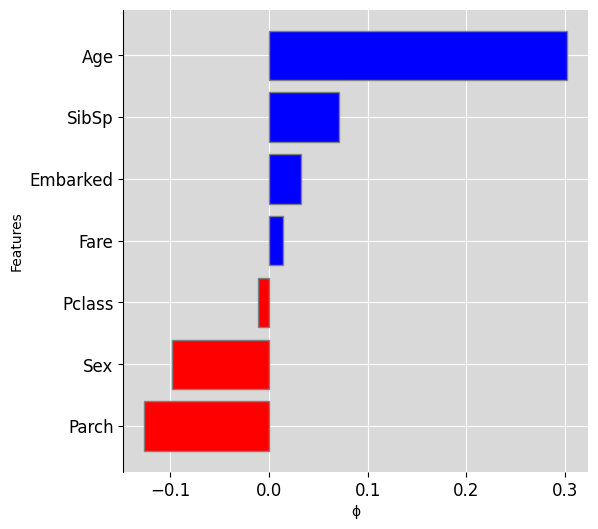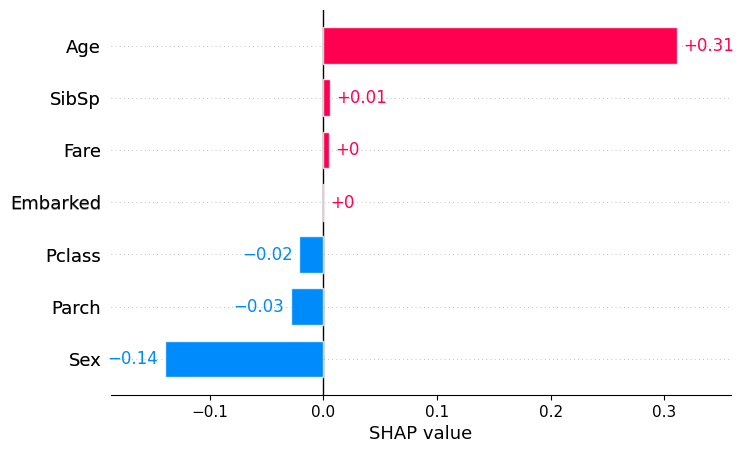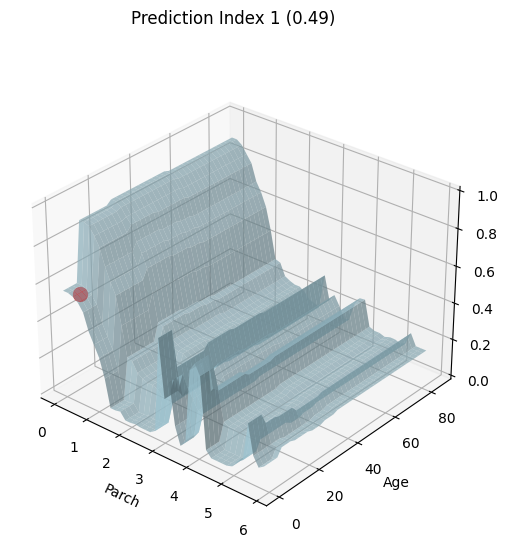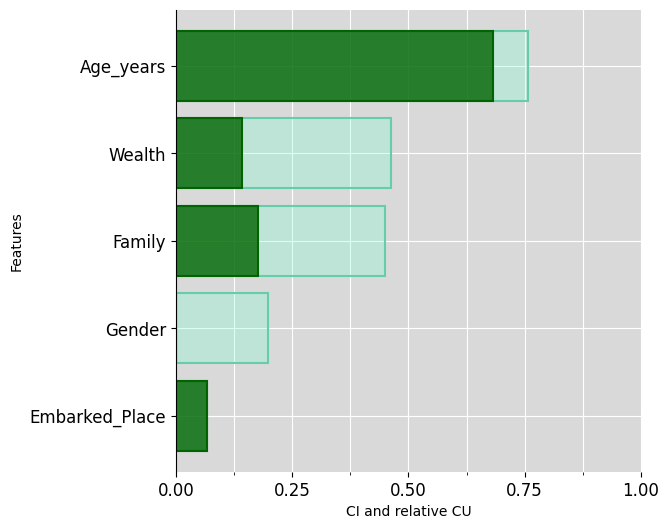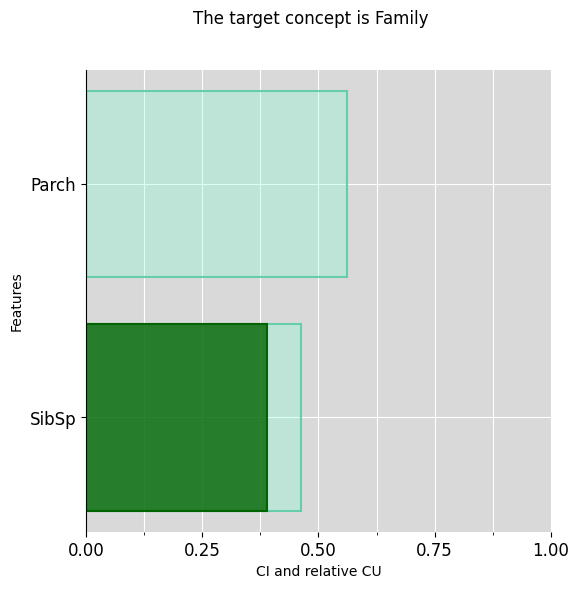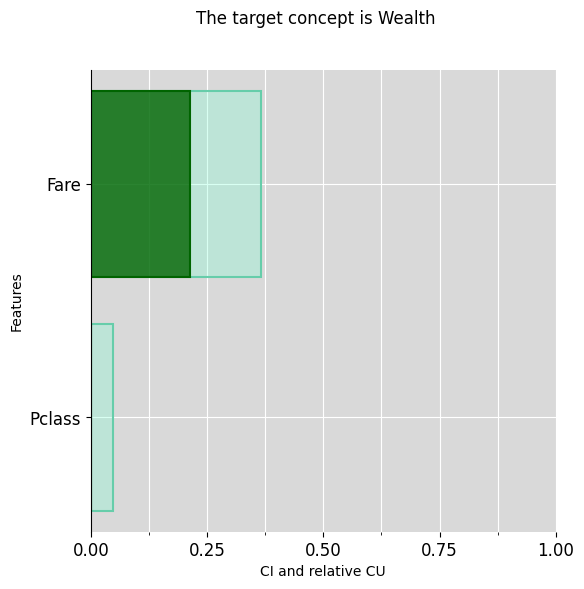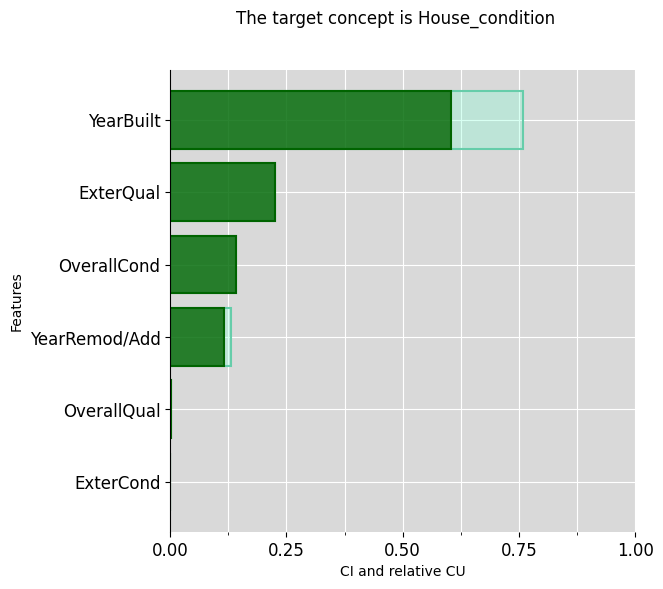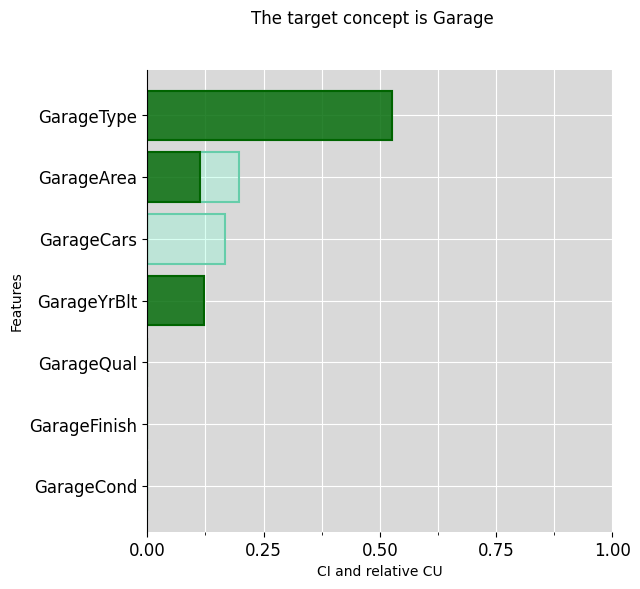Explainable Machine Learning through Contextual Importance and Utility
NOTE: This python implementation is currently a work in progress. As such some of the functionality present in the original R version is not quite yet available.
The py-ciu library provides methods to generate post-hoc explanations for machine learning-based classifiers.
Remark: It seems like Github Markdown doesn’t show correctly the “{”
and “}” characters in Latex equations, whereas they are shown correctly
in Rstudio. Therefore, in most cases where there is an {i} and where there is an {I}.
CIU is a model-agnostic method for producing outcome explanations of
results of any “black-box” model y=f(x). CIU directly estimates two
elements of explanation by observing the behaviour of the black-box
model (without creating any “surrogate” model g of f(x)).
Contextual Importance (CI) answers the question: how much can the
result (or the utility of it) change as a function of feature
Contextual Utility (CU) answers the question: how favorable is the
value of feature
CI of one feature or a set of features (jointly)
where
where
CU is defined as
When
where
First, install the required dependencies. NOTE: this is to be run in your environment's terminal;
some environments such as Google Colab might require an exclamation mark before the command, such as !pip install.
pip install py-ciu
Import the library:
from ciu import determine_ciuNow, we can call the determine_ciu function which takes the following parameters:
-
case: A dictionary that contains the data of the case. -
predictor: The prediction function of the black-box model py-ciu should call. -
dataset: Dataset to deduct min_maxs from (dictionary). Defaults toNone. -
min_maxs(optional): dictionary ('feature_name': [min, max, is_int]for each feature), or infered from dataset. Defaults toNone -
samples(optional): The number of samples py-ciu will generate. Defaults to1000. -
prediction_index(optional): In case the model returns several predictions, it is possible to provide the index of the relevant prediction. Defaults toNone. -
category_mapping(optional): A mapping of one-hot encoded categorical variables to lists of categories and category names. Defaults toNone. -
feature_interactions(optional): A list of{key: list}tuples of features whose interactions should be evaluated. Defaults to[].
Here we can use a simple example with the well known Iris flower dataset
import pandas as pd
import numpy as np
from sklearn.model_selection import train_test_split
from sklearn import datasets
from sklearn.discriminant_analysis import LinearDiscriminantAnalysis
iris=datasets.load_iris()
df = pd.DataFrame(data = np.c_[iris['data'], iris['target']],
columns = iris['feature_names'] + ['target'])
df['species'] = pd.Categorical.from_codes(iris.target, iris.target_names)
df.columns = ['s_length', 's_width', 'p_length', 'p_width', 'target', 'species']
X = df[['s_length', 's_width', 'p_length', 'p_width']]
y = df['species']
X_train, X_test, y_train, y_test = train_test_split(X, y, test_size=0.3, random_state=123)Then create and train a model, in this case an LDA model
model = LinearDiscriminantAnalysis()
model.fit(X_train, y_train)Now simply use our Iris flower data and the model, following the parameter descriptions above
iris_df = df.apply(pd.to_numeric, errors='ignore')
iris_ciu = determine_ciu(
X_test.iloc[[42]],
model.predict_proba,
iris_df.to_dict('list'),
samples = 1000,
prediction_index = 2
)Let's import a test from the ciu_tests file
from ciu_tests.boston_gbm import get_boston_gbm_testThe get_boston_gbm_test function returns a CIU Object that we can simply store and use as such
boston_ciu = get_boston_gbm_test()
boston_ciu.explain_tabular()Now we can also plot the CI/CU values using the CIU Object's plot_ciu function
boston_ciu.plot_ciu()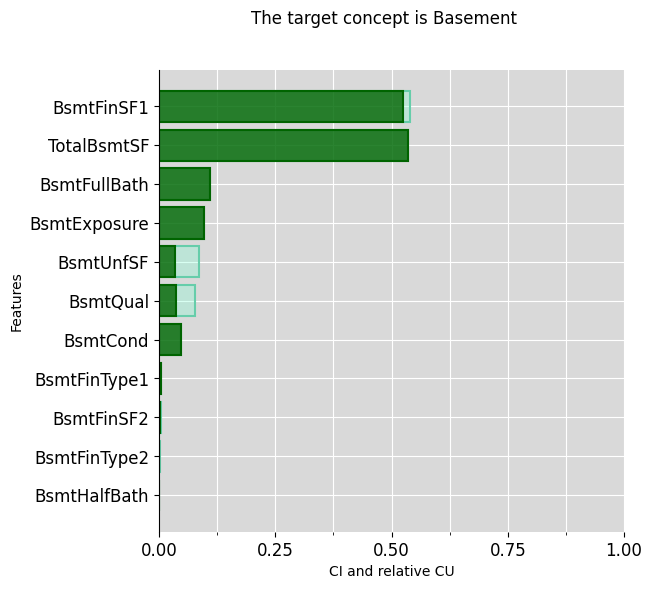 Likewise there are also several options available using the following parameters:
Likewise there are also several options available using the following parameters:
plot_mode: defines the type plot to use between 'default', 'overlap' and 'combined'.include: defines whether to include interactions or not.sort: defines the order of the plot bars by the 'ci' (default), 'cu' values or unsorted if None.color_blind: defines accessible color maps to use for the plots, such as 'protanopia',
'deuteranopia' and 'tritanopia'.color_edge_cu: defines the hex or named color for the CU edge in the overlap plot mode.color_fill_cu: defines the hex or named color for the CU fill in the overlap plot mode.color_edge_ci: defines the hex or named color for the CI edge in the overlap plot mode.color_fill_ci: defines the hex or named color for the CI fill in the overlap plot mode.
Here's quick example using some of these parameters to create a modified version of the above plot
boston_ciu.plot_ciu(plot_mode="combined", color_blind='tritanopia', sort='cu')Contextual influence and can be calculated from CI and CU as follows:
where
Note: the dataset and model used are not identical to the R version, therefore the results will see a slight variance.
import pandas as pd
from sklearn.ensemble import RandomForestClassifier
from ciu.ciu_core import determine_ciu
data = pd.read_csv("https://raw.githubusercontent.com/KaryFramling/py-ciu/master/ciu_tests/data/titanic.csv")
data = data.drop(data.columns[0], axis=1)
unused = ['PassengerId','Cabin','Name','Ticket']
for col in unused:
data = data.drop(col, axis=1)
from sklearn.preprocessing import LabelEncoder
data = data.dropna().apply(LabelEncoder().fit_transform)
train = data.drop('Survived', axis=1)
model = RandomForestClassifier(n_estimators=100)
model.fit(train, data.Survived)Creating a new instance for the CIU Object
# Create test instance (8-year old boy)
new_passenger = pd.DataFrame.from_dict({"Pclass" : [1], "Sex": [1], "Age": [8], "SibSp": [0], "Parch": [0], "Fare": [72], "Embarked": [2]})
ciu_titanic = determine_ciu(
new_passenger,
model.predict_proba,
train.to_dict('list'),
samples = 1000,
prediction_index = 1,
intermediate_concepts=intermediate_tit
)Output a barplot using Contextual Influence:
ciu_titanic.plot_ciu(use_influence=True, include_intermediate_concepts='no')Remark: The Equation for Contextual influence is similar to the
definition of Shapley values for linear models, except that the input
value
Influence values give no counter-factual information and are easily
misinterpreted. Below, we create a Shapley value explanation using the
IML package. In that explanation, for instance the close-to-zero Shapley
value for
import shap
explainer = shap.Explainer(model, train)
shap_values = explainer(new_passenger)
shap.plots.bar(shap_values[0,:,1], order=np.argsort(shap_values[0,:,1].values)[::-1])It might be worth mentioning also that the Shapley value explanation has a much greater variance than the CIU (and Contextual influence) explanation with same number of samples. This is presumably due to the fundamental difference between estimating min/max output values for CIU, compared to estimating a kind of gradient with AFA methods.
CIU can use named feature coalitions and structured vocabularies. Such vocabularies allow explanations at any abstraction level and can make explanations interactive.
The following code snippet plots the joint effect of features
ciu_titanic.plot_3D(ind_inputs=[4,2])We define a small vocabulary for Titanic as follows:
intermediate_tit = [
{"Wealth":['Pclass', 'Fare']},
{"Family":['SibSp', 'Parch']},
{"Gender":['Sex']},
{"Age_years":['Age']},
{"Embarked_Place":['Embarked']}
]Then we create a new CIU object that uses that vocabulary and get top-level explanation.
ciu_titanic = determine_ciu(
new_passenger,
model.predict_proba,
train.to_dict('list'),
samples = 1000,
prediction_index = 1,
intermediate_concepts=intermediate_tit
)First barplot explanation:
ciu_titanic.plot_ciu(include_intermediate_concepts='only', plot_mode='overlap')Then explain WEALTH and FAMILY
ciu_titanic.plot_ciu(target_concept="Family", plot_mode="overlap")ciu_titanic.plot_ciu(target_concept="Wealth", plot_mode="overlap")Same thing using textual explanations:
ciu_titanic.explain_text(include_intermediate_concepts="only")## The feature "Wealth", which is of normal importance (CI=46.15%), is somewhat typical for its prediction (CU=30.95%).
## The feature "Family", which is of normal importance (CI=45.05%), is somewhat typical for its prediction (CU=39.02%).
## The feature "Gender", which is of very low importance (CI=19.76%), is not typical for its prediction (CU=0.1%).
## The feature "Age_years", which is of high importance (CI=75.82%), is very typical for its prediction (CU=89.86%).
## The feature "Embarked_Place", which is of very low importance (CI=6.59%), is very typical for its prediction (CU=100.0%)
ciu_titanic.explain_text(target_concept="Family")## 'The intermediate concept "Family", is somewhat typical for its prediction (CU=39.02%).',
## 'The feature "SibSp", which is of normal importance (CI=46.34%), is very typical for its prediction (CU=84.21%).',
## 'The feature "Parch", which is of normal importance (CI=56.1%), is not typical for its prediction (CU=0.1%).'
ciu_titanic.explain_text(target_concept="Wealth")## 'The intermediate concept "Wealth", is somewhat typical for its prediction (CU=30.95%).',
## 'The feature "Pclass", which is of very low importance (CI=4.76%), is not typical for its prediction (CU=0.1%).',
## 'The feature "Fare", which is of low importance (CI=36.51%), is typical for its prediction (CU=58.7%).'
Ames housing is a data set about properties in the town Ames in the US. It contains over 80 features that can be used for learning to estimate the sales price. The following code imports the data set, does some pre-processing and trains a Gradient Boosting model:
from ciu.ciu_core import determine_ciu
import pandas as pd
import xgboost as xgb
from sklearn.model_selection import train_test_split
df = pd.read_csv('AmesHousing.csv')
#Checking for missing data
missing_data_count = df.isnull().sum()
missing_data_percent = df.isnull().sum() / len(df) * 100
missing_data = pd.DataFrame({
'Count': missing_data_count,
'Percent': missing_data_percent
})
missing_data = missing_data[missing_data.Count > 0]
missing_data.sort_values(by='Count', ascending=False, inplace=True)
#This one has spaces for some reason
df.columns = df.columns.str.replace(' ', '')
#Taking care of missing values
from sklearn.impute import SimpleImputer
# Group 1:
group_1 = [
'PoolQC', 'MiscFeature', 'Alley', 'Fence', 'FireplaceQu', 'GarageType',
'GarageFinish', 'GarageQual', 'GarageCond', 'BsmtQual', 'BsmtCond',
'BsmtExposure', 'BsmtFinType1', 'BsmtFinType2', 'MasVnrType'
]
df[group_1] = df[group_1].fillna("None")
# Group 2:
group_2 = [
'GarageArea', 'GarageCars', 'BsmtFinSF1', 'BsmtFinSF2', 'BsmtUnfSF',
'TotalBsmtSF', 'BsmtFullBath', 'BsmtHalfBath', 'MasVnrArea'
]
df[group_2] = df[group_2].fillna(0)
# Group 3:
group_3a = [
'Functional', 'MSZoning', 'Electrical', 'KitchenQual', 'Exterior1st',
'Exterior2nd', 'SaleType', 'Utilities'
]
imputer = SimpleImputer(strategy='most_frequent')
df[group_3a] = pd.DataFrame(imputer.fit_transform(df[group_3a]), index=df.index)
df.LotFrontage = df.LotFrontage.fillna(df.LotFrontage.mean())
df.GarageYrBlt = df.GarageYrBlt.fillna(df.YearBuilt)
#Label encoding
from sklearn.preprocessing import LabelEncoder
df = df.apply(LabelEncoder().fit_transform)
data = df.drop(columns=['SalePrice'])
target = df.SalePrice
#Splitting and training
X_train, X_test, y_train, y_test = train_test_split(data, target, test_size=0.3, random_state=123)
xg_reg = xgb.XGBRegressor(objective ='reg:squarederror', colsample_bytree = 0.5, learning_rate = 0.1, max_depth = 15, alpha = 10)
xg_reg.fit(X_train,y_train)Then we create our vocabulary of intermediate concepts, in this case a list containing dictionaries of a concept->[columns]structure as follows:
intermediate = [
{"Garage":list(df.columns[[58,59,60,61,62,63]])},
{"Basement":list(df.columns[[30,31,33,34,35,36,37,38,47,48]])},
{"Lot":list(df.columns[[3,4,7,8,9,10,11]])},
{"Access":list(df.columns[[13,14]])},
{"House_type":list(df.columns[[1,15,16,21]])},
{"House_aesthetics":list(df.columns[[22,23,24,25,26]])},
{"House_condition":list(df.columns[[17,18,19,20,27,28]])},
{"First_floor_surface":list(df.columns[[43]])},
{"Above_ground_living area":[c for c in df.columns if 'GrLivArea' in c]}
]Now we can initialise the CIU object with a relatively favourable test case and our newly defined intermediate concepts:
test_data_ames = X_test.iloc[[345]]
ciu = determine_ciu(
test_data_ames,
xg_reg.predict,
df.to_dict('list'),
samples = 1000,
prediction_index = None,
intermediate_concepts = intermediate
)We start with an “explanation” using all 80 basic features, which is not very readable and overly detailed for “ordinary” humans to understand:
ciu_ames.plot_ciu(include_intermediate_concepts='no', plot_mode='overlap')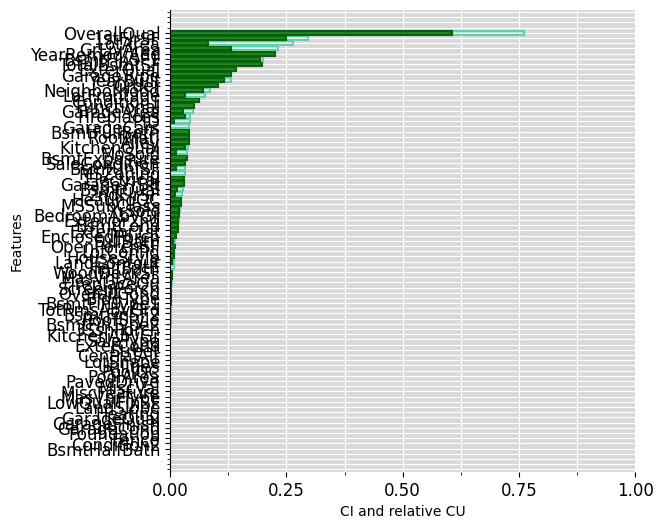 Then the same, using highest-level concepts:
Then the same, using highest-level concepts:
ciu_ames.plot_ciu(include_intermediate_concepts='only', plot_mode='overlap')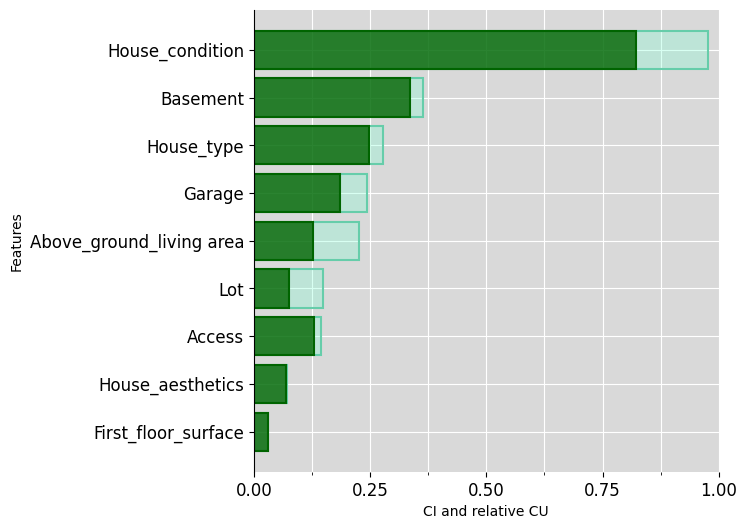 Then explain further some intermediate concepts:
Then explain further some intermediate concepts:
ciu_ames.plot_ciu(target_concept="House_condition", plot_mode="overlap")ciu_ames.plot_ciu(target_concept="Basement", plot_mode="overlap")ciu_ames.plot_ciu(target_concept="Garage", plot_mode="overlap")This vocabulary is just an example of what kind of concepts a human typically deals with. Vocabularies can be built freely (or learned, if possible) and used freely, even so that different vocabularies can be used with different users.
The original R implementation can be found at: https://github.com/KaryFramling/ciu
There are also two implementations of CIU for explaining images:
Image explanation packages can be considered to be at proof-of-concept level (Nov. 2022). Future work on image explanation will presumably focus on the Python version, due to the extensive use of deep neural networks that tend to be implemented mainly for Python.
The current version of py-ciu re-uses research code provided by Timotheus Kampik and replaces it. The old code is available in the branch "Historical".
